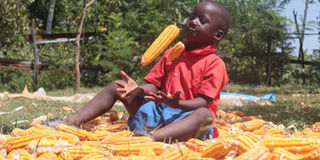State mulls importing yellow maize

A child plays with yellow maize in Homa Bay County. FILE PHOTO | TOM OTIENO | NATION MEDIA GROUP
What you need to know:
- Mr Rotich, whose docket is mandated with issuing waivers on imports, said the current shortage of maize might warrant importation of duty free the yellow variety.
Treasury Cabinet Secretary Henry Rotich says the government will this week decide whether to allow millers to import yellow maize duty free for manufacturing of animal feed to ease pressure on white maize amid the biting shortage.
Mr Rotich, whose docket is mandated with issuing waivers on imports, said the current shortage of maize might warrant importation of duty free the yellow variety.
“A multi-agency team is currently conducting an assessment of the situation and it will inform us appropriately on the action to take. We want to see if we might allow millers to import yellow maize at duty free in order to ease competition for white maize,” said Mr Rotich.
Make animal feeds
Millers have over the years urged the government to allow them import yellow maize at duty free to be used for manufacturing of animal feeds so that white maize can exclusively be used for human consumption.
On Thursday, Agriculture Cabinet Secretary Willy Bett said there were 21 million bags of maize in the country as at the end of December.
“The maize stocks as at December 31 were 21 million bags of 90 kilogrammes, this stocks could take the country to early June, however, the stocks are for both human consumption and animal feeds production,” said Mr Bett.
Half of the country is currently faced with starvation resulting from a ravaging drought that has hit most parts of Kenya and indeed Africa.
The latest findings by Tegemeo Institute of Research indicated that Kenya produces enough maize to feed the population based on estimated per capita consumption but when other uses such as seed, feeds manufacturing are considered the supply falls short of demand.
Report on food situation by the Ministry of Agriculture shows that two per cent of total maize harvest is used in making animal feeds while one per cent is retained as seeds.
“When this percentage is diverted from human consumption to other uses, then it cuts down on available stocks, creating a shortage,” said Mr James Githuku, senior research associate at Tegemeo.
Plant at Galana
Eastern African Grain Council executive director Gerald Masila said the government should plant yellow maize on part of the Galana Irrigation Scheme to cater for animal feeds, which eat into substantial maize stocks meant for human use.
“Kenya is a maize-deficit country and using white maize for animal feed manufacturing eats substantially into the little stocks that we have, the government has to come up with alternatives,” said Mr Masila.
Food shortage in Kenya is a cyclic scenario with the country registering a deficit of 20 million bags annually. To bridge the deficit, Kenya relies on cross-border imports from Tanzania and Uganda.
According to the study by Tegemeo, majority of the population, both rural and urban, and across income groups consider maize and maize meal as the important items in their household food basket.
Millers have welcomed the move by government on yellow maize saying it will play an important role in easing pressure on white maize.
“It is a good step and the government should make an immediate move to allow millers bring in the yellow maize in the country for production of animal feeds so that we can leave the white one for human use,” said the chairperson of Cereal Millers Association Nick Hutchinson.




